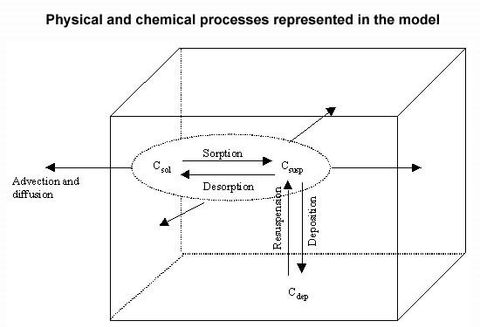MARINE DISPERSION
MARINE DISPERSION
FACSIMILE has been used to simulate the long-term dispersion and retention of radionuclides discharged into coastal waters from the nuclear fuel reprocessing facility at Sellafleld, Cumbria.
MODELLING RADIONUCLIDE DISPERSION IN THE IRISH SEA
Low-level radioactive waste is discharged, under authorisation, from Sellafield into the eastern Irish Sea. These discharges began in the early 1950s, reached a peak in the mid-1970s and are now typically only a small fraction of their earlier maxima. The eastern Irish Sea is a relatively shallow (approximately 20m deep) expanse of water whose underlying bed sediments include a characteristic mud bank close to the coast of West Cumbria.
The behaviour of radionuclides after discharge depends on the degree to which they adsorb into sediments. Some radionuclides, such as 137Cs, are largely soluble and are dispersed out of the region on a timescale of a few months. Other radionuclides, including isotopes of plutonium and americium, readily adsorb onto sediments and become entrained in a cycle of deposition and remobilisation or burial within the seabed. Measurements by the Ministry of Agriculture, Fisheries and Food (MAFF) indicate that over half the plutonium discharged from Sellafield is still retained within seabed sediments.
A numerical model (Figure a) has been developed to predict concentrations in the Irish Sea over the next few decades. The processes controlling the dispersion of radionuclides are represented in the model by advective and diffusive mixing in the water column, coupled with the interaction of radionuclides with particles suspended in the water column and deposited on the seabed.
To simulate transport in the water column, the model calculates by finite differences the solution of the two-dimensional advection-diffusion equation. The coefficients describing transport are taken to be constant in time and are based on annually averaged values. A stream function is used to implement the advective residual current arising from tidal motions, wind-driven or density currents. The residual current was taken from a hydrodynamic model. Diffusion is used to represent tidal mixing and shear-diffusion.
Radionuclides are treated in the model as being distributed between three phases, i.e. dissolved in seawater, attached to suspended material and deposited in the seabed. The dissolved and suspended phases are both assumed to be transported with the water flow rates. Exchange between the water column and the seabed takes place by a representation of the mechanisms of deposition and resuspension.
Distributions of 137Cs are controlled by water movements, so a radionuclide may itself be used as a tracer and the marine model has been calibrated against measurements of 137Cs.
The schematic in Figure (a) illustrates the principal mechanisms represented in the model. The model has been extensively compared against measured distributions of radionuclides in the Irish Sea. Good agreement is obtained between the calculated levels of caesium, plutonium and americium. An illustration of typical output is shown in Figure (b).




